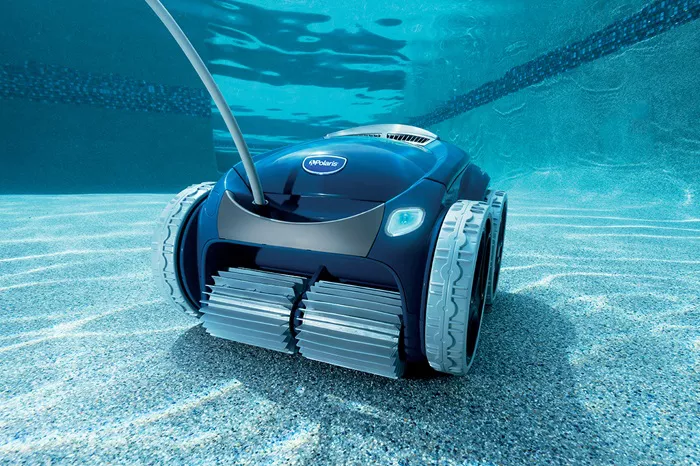Robotic pool cleaners are automated devices designed to clean swimming pools without the need for manual labor. These machines move around the pool, scrubbing and vacuuming dirt, debris, and algae from the floor, walls, and waterline. They have become popular because they save time, effort, and improve pool hygiene.
This article will explain how robotic pool cleaners work, their main features, benefits, types, and some practical tips to choose the right model for your pool.
How Do Robotic Pool Cleaners Work?
Basic Components
Most robotic pool cleaners have a few key parts:
- Electric motor: Powers the movement and cleaning brushes.
- Filter system: Captures dirt and debris inside the machine.
- Brushes and scrubbers: Loosen algae and dirt from pool surfaces.
- Navigation system: Helps the cleaner move efficiently and avoid obstacles.
Operation
The cleaner is placed in the pool and connected to a power supply. It moves around the pool automatically, scrubbing surfaces and sucking up debris into its filter. Many models have sensors to detect dirtier areas or walls, ensuring thorough cleaning. Once done, you lift the cleaner out, empty the filter, and store the device.
Main Features of Robotic Pool Cleaners
Energy Efficiency
Robotic pool cleaners use low voltage electricity, making them energy efficient. They often consume less power than traditional pool cleaning systems, which depend on the pool’s main pump.
Ease of Use
These cleaners require minimal setup. Most models are plug-and-play: just place the robot in the water, press start, and let it work. The user does not need to control or steer it.
Self-contained Operation
Robotic cleaners have built-in filtration systems. They clean the pool water as they work, reducing the load on your pool’s main filter system.
Programmable and Smart Features
Advanced models come with programmable cleaning cycles and remote controls. Some have smartphone apps that allow users to set cleaning schedules or track cleaning progress.
Versatility
These cleaners can work on different pool surfaces, such as concrete, vinyl, and fiberglass. They also handle various pool shapes and sizes, including above-ground and in-ground pools.
Benefits of Using Robotic Pool Cleaners
Time-Saving
One of the biggest advantages is the time saved. Instead of manually vacuuming or using cumbersome hoses and brushes, the robotic cleaner does all the work. This frees up pool owners to relax and enjoy their pool more.
Improved Cleaning Quality
Robotic pool cleaners provide a consistent and thorough clean. They scrub algae, remove fine dirt, and clean hard-to-reach areas like steps and corners better than manual cleaning.
Cost-Effective
Though the initial price can be higher, robotic pool cleaners save money in the long term by reducing pool maintenance costs and extending the life of the pool’s filtration system.
Environmentally Friendly
Because they use less energy and clean the pool water efficiently, robotic pool cleaners are more eco-friendly compared to traditional cleaning methods.
Types of Robotic Pool Cleaners
Basic Robotic Cleaners
These are entry-level models that mainly clean the pool floor. They move randomly and are suited for small to medium-sized pools.
Advanced Robotic Cleaners
These models clean the pool floor, walls, and waterline. They use sensors and mapping technology for efficient cleaning patterns and better dirt detection.
Smart Robotic Cleaners
Equipped with Wi-Fi, smartphone apps, and programmable schedules, these are the most advanced cleaners. They often include features like voice control and obstacle avoidance.
How to Choose the Right Robotic Pool Cleaner
Consider Pool Size and Shape
Large or irregularly shaped pools need cleaners with advanced navigation and longer battery life or cable length. Small pools can use simpler models.
Surface Material
Check if the cleaner is compatible with your pool’s surface. Some brushes are designed for delicate vinyl, while others scrub hard concrete surfaces.
Cleaning Needs
Think about the type and amount of debris you typically have. If your pool often has leaves and large debris, choose a model with a large filter capacity and powerful suction.
Budget
Prices vary widely. Basic models may cost a few hundred dollars, while advanced smart cleaners can reach over a thousand. Balance features with your budget.
Maintenance Tips for Robotic Pool Cleaners
Regularly Clean the Filter
Empty and rinse the filter after every cleaning to maintain suction power and prevent clogging.
Inspect Brushes and Tracks
Check for wear and tear on brushes and wheels or tracks. Replace them as needed for optimal cleaning performance.
Store Properly
Keep the cleaner out of direct sunlight and store it in a dry place to prolong its life.
Common Challenges and Solutions
Tangles and Cables
Some robotic cleaners use power cables that can tangle. Look for swivel cables or wireless models to reduce this issue.
Battery Life
Battery-powered models need regular charging. Always follow the manufacturer’s instructions to extend battery life.
Initial Cost
High upfront prices may deter some users. Consider long-term savings on energy and pool maintenance to justify the investment.
Future Trends in Robotic Pool Cleaners
Improved AI and Navigation
Newer models will have smarter AI to map pools more precisely and avoid obstacles more efficiently.
Integration with Smart Home Systems
More robotic cleaners will integrate with home assistants like Alexa and Google Home for voice commands and automation.
Eco-friendly Designs
Expect future models to use even less energy and include biodegradable or recyclable parts to reduce environmental impact.
Conclusion
Robotic pool cleaners are revolutionizing pool maintenance by providing a simple, efficient, and eco-friendly way to keep pools clean. From basic models that cover the floor to advanced smart cleaners with remote control, there is a solution for every pool owner. Proper selection and maintenance can ensure these devices deliver excellent results and long-lasting service.
For those interested in extending cleaning automation beyond pools, exploring steam cleaner types and steam cleaner uses can offer more insight into modern cleaning technologies.

